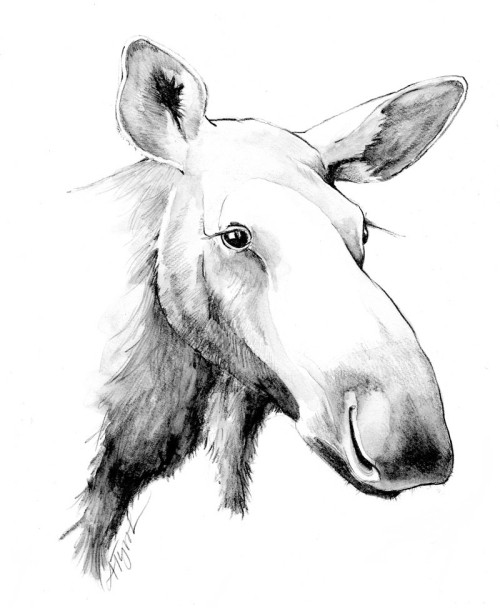
The Algonquin called them “moos,” a word for “twig eaters.” In winter moose munch on the buds and new growth of aspen, willow and other trees; they may even use their lower incisors to strip bark off a young maple. It’s a diet only a moose could love. It’s also a low-salt diet.
The woody, terrestrial browse that moose eat during winter has one-hundredth the sodium of the aquatic plants they consume in summer, explains Cedric Alexander, the moose biologist for the Vermont Fish and Wildlife Department. When spring comes, moose have a chemical imbalance that they can’t wait to address, he says.
What do they do? Many head for areas along highways where they find road salt runoff. Alexander says moose visit those areas throughout summer and into fall. These highway ‘saltlicks’ are a big reason why May and June are so dangerous for both moose and motorists in Northern New England.
Kristine Rines, a biologist for the New Hampshire Fish and Game Department, says moose are moving about for other reasons as well. Adult moose in spring are heading down from their winter ranges at higher elevations to their summer ranges in wet lowlands. Yearlings, too, are traveling, looking for new territories, having just been cut loose by their mothers.
“A cow will drive off the yearling just before she calves in the spring,” Rines says. The yearlings have been known to travel long distances: “We had one travel (from New Hampshire) to Rhode Island,” she says.
Busy as interstates and other highways may be, they don’t seem to scare off moose.
About 170 moose are killed each year on roads in Vermont, which has an estimated moose population of 3,800; about 230 moose are killed each year in New Hampshire, with a population of roughly 6,000.
Highway accidents involving moose take a serious human toll. An average of one person dies each year in New Hampshire; 15 people have been killed over the past 25 years in Vermont.
Wildlife biologists say the moose populations are growing in both states and may already be too high in some areas, such as Vermont’s Northeast Kingdom. A moose will live 10 or 12 years unless killed by a vehicle, shot by a hunter, or felled by disease, such as brainworm.
One reason for human fatalities and serious injury is the fact moose are so big. An adult moose can weigh 1,000 pounds or more and measure six feet tall at the shoulder. A car will hit a moose in the legs, which means the huge animal might smash through the windshield or land on the car’s roof.
Avoiding a moose in the road at night can be difficult, because they are hard to see. Headlights sometimes illuminate only their legs, which are thin and dark in color and may not stand out, says David LeCours, Vermont’s head game warden. A large moose’s eye level is typically above the beam of the headlights, so less light is reflected back to the driver.
Moose in New Hampshire and Vermont have no natural predators, so they are relatively fearless. They often show little concern about an approaching vehicle.
As a result, both states post warning signs along highway sections often crossed by moose.
In addition, Vermont has been clearing brush along the sides of roads that moose frequent to give motorists a better view of what might be coming. When building or rebuilding bridges, the state has been widening clearances across riverbanks, so moose can travel underneath and not be tempted to cross a road, according to the Vermont Agency of Transportation.
For years, New Hampshire has been running a “Brake for Moose” campaign, featuring bumper stickers and other public-service reminders that moose are on the move. As part of the effort, the state has improved lighting in high-traffic zones where motorists are likely to encounter moose; it sets up scrolling-message warning signs in moose-traveled areas; and it sends out safety videos, public service announcements and press releases.
The “Brake for Moose” campaign is the state’s response to concerns voiced nearly two decades ago by a Littleton emergency-room doctor, who had patched up one too many motorists who had slammed into a moose.

